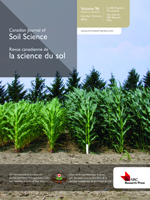Reynolds, W. D., Drury, C. F., Yang, X. M., Tan, C. S. and Yang, J. Y. 2014. Impacts of 48 years of consistent cropping, fertilization and land management on the physical quality of a clay loam soil. Can. J. Soil Sci. 94: 403-419. Soil physical quality (SPQ) is often ignored or under-monitored in long-term field studies designed to determine the economic and environmental sustainability of agricultural practices. Accordingly, a suite of complementary soil physical and hydraulic parameters was measured using intact core samples to determine the SPQ of a Brookston clay loam under a long-term (48 yr) cropping, fertilization and land management study at Woodslee, Ontario. The SPQ under virgin woodlot, fertilized monoculture sod and unfertilized monoculture sod treatments was similar, with optimal SPQ occurring in the top 10-20 cm, but severely suboptimal SPQ occurring below 30 cm because bulk density (BD), relative field capacity (RFC) and saturated hydraulic conductivity (KS) were excessive, and because organic carbon (OC), air capacity (AC) and plant-available water capacity (PAWC) were critically low. The SPQ for fertilized and unfertilized monoculture corn under fall moldboard plow tillage was similar and substantially suboptimal throughout the top 40-50 cm due to high or excessive BD and RFC, critically low OC, low or critically low AC and PAWC, and KS that varied erratically from excessive to critically low. The SPQ under fertilized and unfertilized corn-oat-alfalfa-alfalfa rotations (corn and second-year alfalfa fall plowed) was similar and largely non-optimal below 10 cm, but largely optimal in the top 10 cm due to the ameliorating effects of numerous biopores and crop roots. A bimodal soil water release function fitted to release curve data showed that PAWC was determined by soil matrix porosity (PM), and AC was determined by soil structure porosity (PS). Strong inverse linear correlations between BD vs. PM, BD vs. PS and BD vs. OC provided site-specific estimates of optimal ranges and critical limits for PAWC, AC and OC, respectively. Although SPQ changed substantially among treatments, the changes did not extend below 30-to 40-cm depth, and were largely unaffected by long-term annual fertilization. The SPQ below 30- to 40-cm depth was similarly poor across all treatments, and is likely an inherent characteristic of the soil.
How to translate text using browser tools
8 August 2014
Impacts of 48 years of consistent cropping, fertilization and land management on the physical quality of a clay loam soil
W. D. Reynolds,
C. F. Drury,
X. M. Yang,
C. S. Tan,
J. Y. Yang
ACCESS THE FULL ARTICLE
It is not available for individual sale.
This article is only available to subscribers.
It is not available for individual sale.
It is not available for individual sale.

Canadian Journal of Soil Science
Vol. 94 • No. 3
August 2014
Vol. 94 • No. 3
August 2014
agricultural sustainability
clay loam soil
étude de longue haleine sur le terrain
loam argileux
long-term field study
paramètres physiques et hydrauliques du sol
pérennité de l'agriculture




